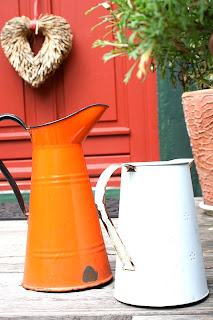If you don't count the calories (and I don't) then baklava is one of the desserts nearest to perfection. The wonderful flavours and sticky sweet texture are mirrored in the aesthetic pleasure of its preparation. Growing up, Middle Eastern sweets were regular visitors to our dining table. My father often made baklava's close relative konafa (known sometimes as kataifi). When we were in Egypt and the fresh hair-like pastry was readily available, he would love to make it for the family and I have memories of keeping him company as he sat at the table patiently separating the delicate strands before painstakingly coating them in melted butter.

Since we arrived in Denmark I've been on the lookout for filo pastry in the supermarkets. It has taken more than six months but I recently found some frozen pastry and so this week I decided to make a tray of the pastries for my family. If I'm honest, there isn't nearly enough chocolate in baklava for my husband and my son picks out the nuts and leaves the pastry in a sticky mess and my eighteen month old daughter is probably a bit young just now for the sugar overload. Yes, the truth is, I wanted to make a tray just for the sheer beauty and pleasure of it!!! I sometimes wonder if such motivations are just heavily disguised pangs of homesickness - who knows...

My recipe for baklava is from Claudia Roden's brilliant Book of Middle Eastern Food. I have the 1986 edition and it is nearly as dog-eared and marked up as the original 1968 edition that lives amongst my parents' cookery books. It's not your usual recipe book - there are no photographs or pictures of the food - but there are pencil sketches that illustrate some of the stories and local folklore that are behind the many authentic recipes and these are set out in some length.

One of the things that does make me laugh about Ms Roden's recipes but is so typical of the way cooking is done in the Middle East (or at least so far as I have experienced it amongst the Egyptians), the quantities of the food are large and there is no concept of a particular recipe serving a given number of people eg 'serves 4' or 'makes 8 helpings'. Each recipe will make enough of a dish to feed a large family with plenty left over for a couple of days. That's the wonderful thing about the Egyptians - they live to eat and not the other way around.
Getting back to the baklava, Ms Roden's introduction to the recipe makes reference to a tale from the time of the Ottoman Empire when such pastries first began to appear in ancient writings. She then goes on to describe the role that baklava and konafa play in Middle Eastern life (it is eaten at weddings and celebrations but also amongst friends with a glass of hot tea) and describes the pastries as easy and cheap to prepare at home.
Of course, nothing in Denmark is cheap and I am afraid I could not find pistachios except in little packets of 55g each costing over £2. The recipe calls for 375g and so this was never going to be a 'cheap' dessert! As I have already mentioned, I was the only one likely to eat the pastry, so I decided to scale down the quantities.
Some people reading this might wonder why I haven't inherited a recipe for baklava from my Egyptian grandmother or my aunts and cousins. Unfortunately, my grandmother Samira died before I had a chance to ask her about this and many other things. When I spent my summers in Egypt with my cousins, I was up to mischief and for the most part tried to keep out of her way. I had no idea then of the things that I might have asked her to teach me. Such is the ignorance of youth and I hope that, if she was watching down on me this week, my efforts didn't disappoint her too badly.
For her part, Ms Roden swears that the secret to a good baklava is to make sure that the syrup is very cold when it is poured over the freshly baked and still hot pastry. For this reason, I have always made the syrup the night before I plan to do the baking. I leave the syrup in the fridge overnight and then pour it over the pastry as it comes out of the oven. So far, it has always worked a treat.

If you are reading this post hoping for a recipe then I am sorry to disappoint you - it would be unfair to reproduce Ms Roden's recipe without the lengthy narrative that gives the dessert its context. I can however hazard a guess at how my grandmother would have explained it to me if I had asked her: Make the syrup but be careful not to let it turn to toffee. Chop the nuts, add some sugar and sprinkle with orange blossom water. Melt the butter. 'How much?', I would ask her, 'About this much' she would say taking an unquantified dollop of ghee from the big tin in the kitchen. 'Or maybe more'. Then I can imagine her laying each sheet of filo pastry in the sanaaya (a round shallow metallic baking dish) brushing each one with the melted butter, adding the chopped nuts mixture and layering the rest on top. If I asked how long it should bake for, I imagine the answer would be, 'Until its ready'. She wouldn't have had a timer or watched the clock but she would know what a baklava looked like when it was ready. Baking these pastries wasn't something that my grandmother and other Egyptian women (especially of her generation) had to learn from a book, it was in their blood.

































